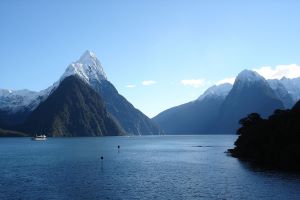1280px-MilfordSound_edit.jpg

Fjords, carved out of the rock by glaciers, may contribute as much methane as all of the deep ocean combined – which may spell trouble for climate change. Credit: Wikikiwiman.
Fjords are some of the most beautiful features on the planet. But they may not be all that beautiful deep down. They may release as much methane into the atmosphere as all the deep oceans combined.
Fjords are jagged notches in rocky coastlines. They formed as glaciers gouged deep into the rock. They’re small—they account for about a tenth of a percent of the total ocean surface. Most are fed by rivers or by streams from melting glaciers.
Their sediments contain a lot of decaying plants and animals, along with fertilizers and other nasty products from the land. They produce methane—a gas that may cause a third of global warming. For the most part, the methane stays deep—a fjord consists of steady layers of water that seldom mix. And most of the methane that does bubble upward is broken down by oxygen in the upper layers.
Researchers studied a fjord in Sweden for a dozen years. They sailed into the fjord, and they deployed robots that sampled water and sediments on the bottom. And they found that when a storm roared through, it stirred up the layers of water. That brought a lot of methane to the surface, where much of it escaped into the air.
The scientists combined their work with studies of other fjords, which found similar results. They then estimated how much methane all fjords could be pumping into the atmosphere: a million tons per year. That’s as much as all the deep oceans—an unpleasant contribution from some beautiful landscapes.

